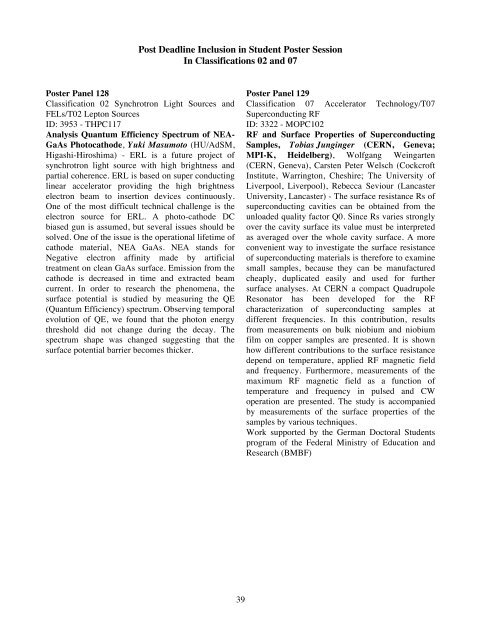Abstracts Brochure - 2nd International Particle Accelerator Conference
Abstracts Brochure - 2nd International Particle Accelerator Conference
Abstracts Brochure - 2nd International Particle Accelerator Conference
Create successful ePaper yourself
Turn your PDF publications into a flip-book with our unique Google optimized e-Paper software.
�<br />
Post Deadline Inclusion in Student Poster Session<br />
In Classifications 02 and 07<br />
Poster Panel 128<br />
Classification 02 Synchrotron Light Sources and<br />
FELs/T02 Lepton Sources<br />
ID: 3953 - THPC117<br />
Analysis Quantum Efficiency Spectrum of NEA-<br />
GaAs Photocathode, Yuki Masumoto (HU/AdSM,<br />
Higashi-Hiroshima) - ERL is a future project of<br />
synchrotron light source with high brightness and<br />
partial coherence. ERL is based on super conducting<br />
linear accelerator providing the high brightness<br />
electron beam to insertion devices continuously.<br />
One of the most difficult technical challenge is the<br />
electron source for ERL. A photo-cathode DC<br />
biased gun is assumed, but several issues should be<br />
solved. One of the issue is the operational lifetime of<br />
cathode material, NEA GaAs. NEA stands for<br />
Negative electron affinity made by artificial<br />
treatment on clean GaAs surface. Emission from the<br />
cathode is decreased in time and extracted beam<br />
current. In order to research the phenomena, the<br />
surface potential is studied by measuring the QE<br />
(Quantum Efficiency) spectrum. Observing temporal<br />
evolution of QE, we found that the photon energy<br />
threshold did not change during the decay. The<br />
spectrum shape was changed suggesting that the<br />
surface potential barrier becomes thicker.<br />
39<br />
Poster Panel 129<br />
Classification 07 <strong>Accelerator</strong> Technology/T07<br />
Superconducting RF<br />
ID: 3322 - MOPC102<br />
RF and Surface Properties of Superconducting<br />
Samples, Tobias Junginger (CERN, Geneva;<br />
MPI-K, Heidelberg), Wolfgang Weingarten<br />
(CERN, Geneva), Carsten Peter Welsch (Cockcroft<br />
Institute, Warrington, Cheshire; The University of<br />
Liverpool, Liverpool), Rebecca Seviour (Lancaster<br />
University, Lancaster) - The surface resistance Rs of<br />
superconducting cavities can be obtained from the<br />
unloaded quality factor Q0. Since Rs varies strongly<br />
over the cavity surface its value must be interpreted<br />
as averaged over the whole cavity surface. A more<br />
convenient way to investigate the surface resistance<br />
of superconducting materials is therefore to examine<br />
small samples, because they can be manufactured<br />
cheaply, duplicated easily and used for further<br />
surface analyses. At CERN a compact Quadrupole<br />
Resonator has been developed for the RF<br />
characterization of superconducting samples at<br />
different frequencies. In this contribution, results<br />
from measurements on bulk niobium and niobium<br />
film on copper samples are presented. It is shown<br />
how different contributions to the surface resistance<br />
depend on temperature, applied RF magnetic field<br />
and frequency. Furthermore, measurements of the<br />
maximum RF magnetic field as a function of<br />
temperature and frequency in pulsed and CW<br />
operation are presented. The study is accompanied<br />
by measurements of the surface properties of the<br />
samples by various techniques.<br />
Work supported by the German Doctoral Students<br />
program of the Federal Ministry of Education and<br />
Research (BMBF)


